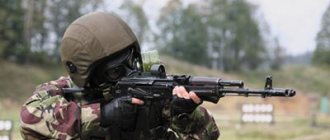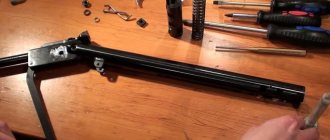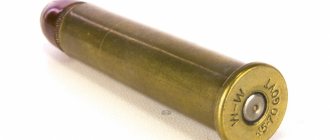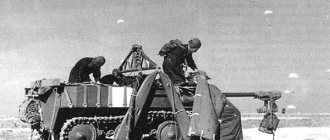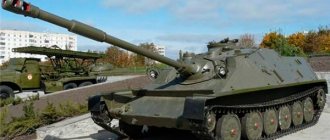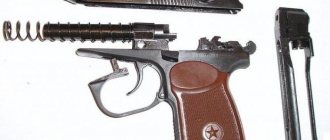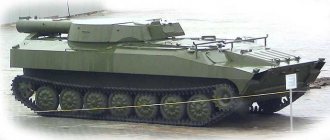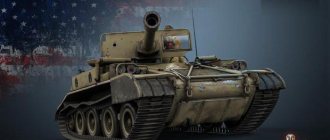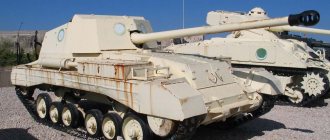| This article includes a list of references, related materials or external links. but its sources remain unclear as it lacks embedded quotations . |
TM-62M
- the wire fuse is locked in place, which clearly indicates that the mine was not armed
TM-62
- designation of a series of Soviet anti-tank landmines. The mines have a central fuse and typically have a 7.5 kg explosive charge, however they vary greatly in detail. Mines can be laid manually or automatically using a mortar vehicle, including wheeled towed minelayers PMR-1, PMR-2, a tracked mine mine vehicle GMZ and a helicopter mining system VMR-2.
In static tests, the TM-62M proved its ability to penetrate the hull of a Centurion tank, killing a simulated team of animals inside.
The TM-62 series mines can be equipped with the same fuses as the TM-72 series mines, including the MVN-72 and MVN-80 fuses, which are sensitive to vibration and magnetism.
Options [edit]
- TM-62M - The TM-62M uses a round metal body. This is the most widely used mine of the TM-62 series.
- TM-62B - The paper or cardboard body of the TM-62B is a block of cast explosive with a fuze mounted in the center.
- TM-62D - The TM-62D uses a wooden body.
- TM-62P, TM-62P2, TM-62P3 - all 3 types use plastic housings. However, the TM-62P and TM-62P2 mine casings have ribbed sides, while the TM-62P3 has smooth sides.
- TM-62T - The TM-62T has a fabric and epoxy casing with a center fuze.
TM-62 (TM-62)
Anti-tank mine TM-62 (TM-62)
TM-62 (TM-62) is a family of Soviet pressure-action anti-tank mines created and adopted by the Soviet army in the 1960s.
Anti-tank mines of the TM-62 (TM-62) family are designed to disable enemy tracked and wheeled vehicles by destroying the chassis by explosion when it hits the mine target sensor.
The family of anti-tank mines TM-62 (TM-62) includes mines: - TM-62B (TM-62B) without a casing, made of a particularly mechanically resistant solid explosive VVO-32; — TM-62D (TM-62D) with a wooden body; — TM-62M (TM-62M) with a metal body; — TM-62P (TM-62P) with a plastic case; — TM-62P2 (TM-62P2) with a plastic case; — TM-62P3 (TM-62P3) with a polyethylene body; — TM-62T (TM-62T) with a fabric body impregnated with epoxy resin.
All mines of the TM-62 (TM-62) family can be used with fuses MV-62, MVZ-62, MVCh-62, MVSh-62, MVP-62, MVK-62, MVD-62.
Anti-tank mine TM-62B (TM-62B)
- anti-tank mine can only be installed manually on the ground, in the ground and in the snow. The mine does not have elements of self-destruction, non-neutralization or non-removal. With fuses MV-62, MVP-62, MVK-62, the mine is not detected by metal detectors (mine detectors).
Tactical and technical characteristics of the anti-tank mine TM-62B (TM-62B)
Mine type : anti-tank, anti-track, pressure action. The case is missing. Total weight - 8.6 kg. The mass of the explosive (VVO-32) is 8.2 kg. Diameter - 315 mm. Height - 128 mm. Target sensor - diameter 90 mm. Triggering force - 200-500 kg.
Anti-tank mine TM-62D (TM-62D)
- anti-tank mine can be installed on the ground, in the ground, in the snow, manually or by means of mechanization - trailed minelayers PMR-3, PMZ-4. Not intended for installation under water or in marshy soil. With fuses MV-62, MVP-62, MVK-62, the mine is not detected by metal detectors (mine detectors). The mine does not have elements of self-destruction, non-neutralization or non-removal.
Tactical and technical characteristics of the anti-tank mine TM-62D (TM-62D)
Mine type : anti-tank, anti-track, pressure action. The body is wood. Total weight - 11.3-13 kg. Weight of explosives (TNT, TGA, MS, A-50, A-80, A-30, PVV-4) - 5.8-11.1 kg. Length - 340 mm. Width - 290 mm. Height - 178 mm. Target sensor - diameter 90 mm. Triggering force - 200-500 kg.
Anti-tank mine TM-62M (TM-62M)
62M anti-tank mine can be installed manually on the ground, in the ground, in the snow, under water or by means of mechanization - trailed mine spreaders PMR-1, PMR-2, trailed minelayers PMZ-3, PMZ-4, tracked minelayers GMZ, helicopter mining system VMR-2. The mine does not have self-destruction elements. The TM-62M mine (TM-62M) in terms of explosion-weight indicators is the most powerful of all Soviet anti-tank mines.
Tactical and technical characteristics of the TM-62M anti-tank mine (TM-62M)
Mine type : anti-tank, anti-track, pressure action. The body is metal. Total weight - 9.5-10 kg. The mass of explosives (TNT, TGA, MS) is 7-7.5 kg. Diameter - 320 mm. Height - 128 mm. Target sensor - diameter 90 mm. Triggering force - 200-500 kg.
Anti-tank mine TM-62P (TM-62P)
62P anti-tank mine is installed only manually on the ground, in the ground, in snow and under water. The mine does not have elements of self-destruction, non-neutralization or non-removal, and is undetectable by mine detectors.
Tactical and technical characteristics of the anti-tank mine TM-62P (TM-62P)
Mine type : anti-tank, anti-track, pressure action. The body is plastic. Total weight - 9-11 kg. Weight of explosives (TNT, TGA, MS, A-90, A-80) - 6.6-7.6 kg. Diameter - 340 mm. Height - 128 mm. Target sensor - diameter 90 mm. Triggering force - 200-500 kg.
Anti-tank mine TM-62P2 (TM-62P2)
The anti-tank mine TM-62P2 (TM-62P2) can be installed on the ground, in the ground, in the snow, under water manually, but is mainly intended for installation by means of mechanization - the tracked mine layer GMZ, GMZ-3, the trailed mine layer PMZ-4, Therefore, the carrying handle is removable. The mine does not have elements of self-destruction, non-neutralization or non-removal, and is difficult to detect by mine detectors.
Tactical and technical characteristics of the anti-tank mine TM-62P2 (TM-62P2)
Mine type : anti-tank, anti-track, pressure action. The body is plastic. Total weight - 9.4-11 kg. Weight of explosives (TNT, TGA, MS, A-90, A-80) - 6.5-7 kg. Diameter - 320 mm. Height - 128 mm. Target sensor - diameter 90 mm. Triggering force - 200-500 kg.
Anti-tank mine TM-62P3 (TM-62P3)
The TM-62P3 anti-tank mine can be installed manually on the ground, in the ground, in the snow, under water or by means of mechanization - trailed mine spreaders PMR-1, PMR-2, trailed minelayers PMZ-3, PMZ-4, tracked minelayers GMZ, helicopter mining system VMR-2. The mine does not have elements of self-destruction, non-neutralization or non-removal, and is undetectable by mine detectors. One of the most powerful tank mines.
Tactical and technical characteristics of the anti-tank mine TM-62P3 (TM-62P3)
Mine type : anti-tank, anti-track, pressure action. The body is polyethylene. Total weight - 8-8.7 kg. Weight of explosives (TNT, TGA, MS) - 6.5-7.2 kg. Diameter - 320 mm. Height - 128 mm. Target sensor - diameter 90 mm. Triggering force - 200-500 kg.
Anti-tank mine TM-62T (TM-62T)
62T anti-tank mine can be installed manually on the ground, in the ground, in the snow, or by means of mechanization - a tracked mine layer GMZ, GMZ-2, a trailed mine layer PMZ-4, a trailed mine spreader PMR-3. The mine does not have elements of self-destruction, non-neutralization or non-removal. With MV-62, MVP-62, MVK-62 fuses, the TM-62T mine is not detectable by mine detectors.
Tactical and technical characteristics of the TM-62T anti-tank mine (TM-62T)
Mine type : anti-tank, anti-track, pressure action. The body is impregnated fabric. Total weight - 7.9-8.1 kg. The mass of explosives (TNT, TGA) is 7-7.9 kg. Diameter - 320 mm. Height - 128 mm. Target sensor - diameter 90 mm. Triggering force - 200-500 kg.
Fuzes[edit]
- MVZ-62
- MHF-62 - MHF-62 uses a delay in turning on the clock mechanism from 30 to 120 seconds.
- MVN-62
- MVN-72 - The MVN-72 fuze uses a combination of electronics and a clock mechanism, after an initial firing delay the magnetic fuze is activated, powered by a 1.5V battery.
- MVN-80 - The MVN-80 is an improved version of the MVN-72 fuze.
- VM-62Z
- MVP-62 - The MVP-62 uses a pneumatic bellows activation delay of 20 to 300 seconds. The delay mechanism uses minimal metal, making it difficult to detect when used with one of the minimal metal housings.
- MVP-62M
- ZN-97 - magnetic fuse (made in Poland).
Note: Magnetic fuses give full width attack, i.e. any part of the target vehicle that passes over the mine will cause detonation, not just the track or wheels. However, since magnetic fuses are electronic, their lifespan depends on the battery charge. Eventually the battery will run out and the mine will stop working. In contrast, a purely mechanical fuze (usually triggered via a belleville spring) gives a much longer service life, for example mines laid 50 years ago will still explode if a target vehicle drives over them.
Anti-tank mines on the land front
The battles of the First World War on land clearly showed the need for engineering reinforcement of the defensive position. In addition to hundreds of kilometers of infantry trenches, there were thousands of kilometers of wire fences. The defending infantry dug deeper into the ground, and the positions of the troops were reinforced in the most vulnerable areas with long-term firing points and other engineering structures. Overcoming such a defense was very difficult, especially for the cavalry, which at that time was the only striking instrument of the ground army. The machine gun and barbed wire became the main components of the defensive order of the warring sides. Against the background of this picture, it seems quite natural for armored vehicles to appear on the battlefield, which could punch a hole in defensive positions with a ramming attack.
On the Western Front, first the British and French, and a little later the Germans, began to successfully use tanks to break through enemy defenses. A massive tank attack could overturn an entire section of the front. The first armored leviathans were far from perfect, moving at a snail's pace and lacking sufficient armor. Despite this, in the warring armies the question arose of how and by what means enemy tanks could be stopped. The idea to use mine weapons came at the right time. Thanks to the embedded high-explosive charge, it was possible to block the directions of the most likely use of tanks. The idea came from the navy, where mine weapons had proven in practice their effectiveness in the fight against superior opponents.
Anti-tank mine of the First World War
The first landmines had a primitive design, which consisted of a set of TNT blocks. Such a mine was more like an explosive device, activated remotely by a person through an electric wire. Due to the limited use of armored vehicles on the battlefield, the first anti-tank mines were placed in single units. The industry had not yet mastered the production of this ammunition, therefore there could be no talk of the massive use of mine weapons on the fields of the First World War. However, the lesson learned was not in vain. The rapid development of armored vehicles, and the resulting change in combat tactics, forced many armies of the world to adopt mine weapons.
https://youtube.com/watch?v=avqHf5YU11E
We need different mines
Anti-personnel mines caused damage not only to soldiers, but also to horses, which constituted the main draft force of armies at the beginning of the 20th century. The mechanical vehicles that appeared, including armored ones, also suffered from charges buried in the ground, but a special design designed to destroy the then clumsy and vulnerable tanks had not yet been invented. The situation changed by the thirties, when it became clear to forward-thinking strategists that the future war would become mobile, and the leading role in it would be played by aviation and armored forces. There is a special conversation about aviation, as modern history has shown, there are also means against it that work automatically... But more on that later. In the meantime, a new type of engineering weapon has emerged - the anti-tank mine. Despite all the fundamental similarities with its anti-personnel “sister”, it differs significantly from it. The problem that the designers solved when designing this charge with a fuse was different.
What should an anti-personnel mine be like?
A device created to effectively destroy manpower must meet a number of tactical requirements. An explosion should create a large number of fragments traveling at sufficient speed to cause maximum damage. At the same time, the mine must be light, otherwise it will be difficult for sappers to carry and install it. An example is the so-called “Petals”. Mines of the PFM-1 and PFM-1S types were copied from American models called “Dragontooth” - BLU-43. They are very modest in size, but cause significant damage to manpower, performing two tasks at once. Firstly, “Petals”, as a rule, do not inflict lethal injuries, but only maim enemy soldiers, which creates an additional burden on the economy of the enemy power
Secondly, they can self-destruct (in modification “C”), which is very important when preparing an offensive
